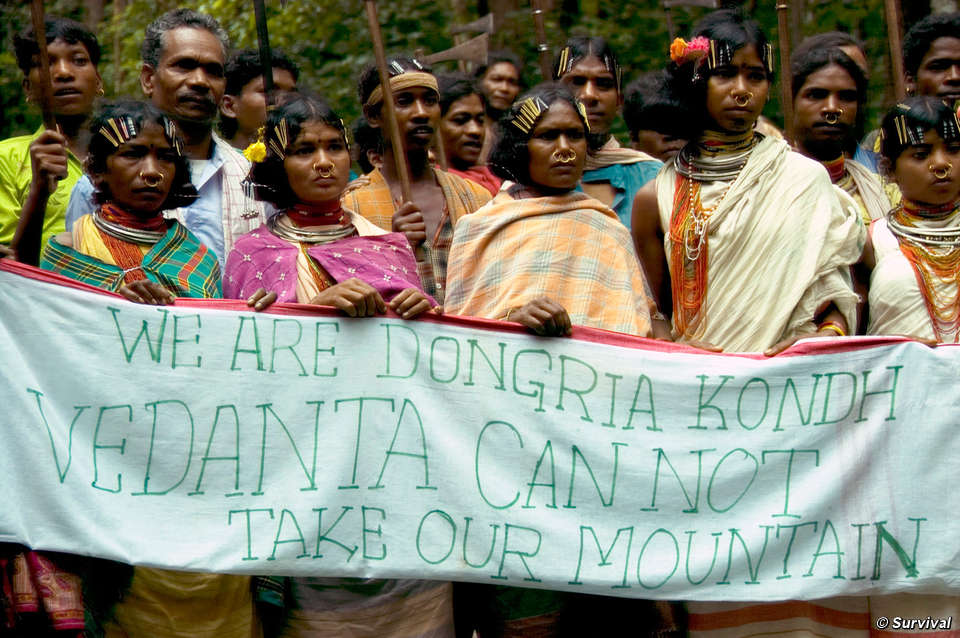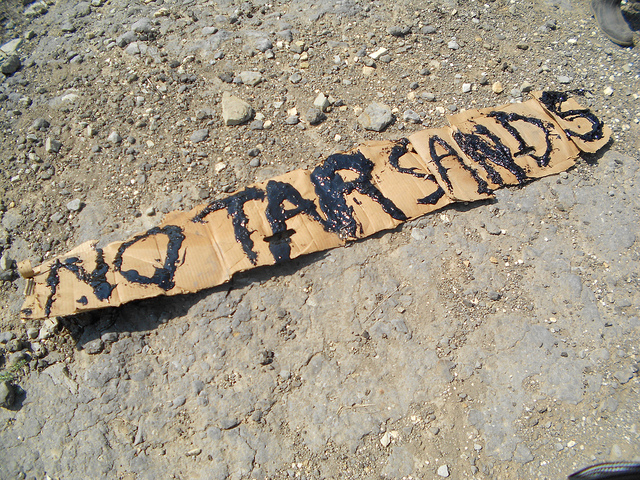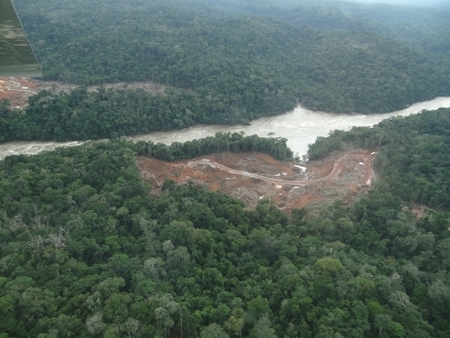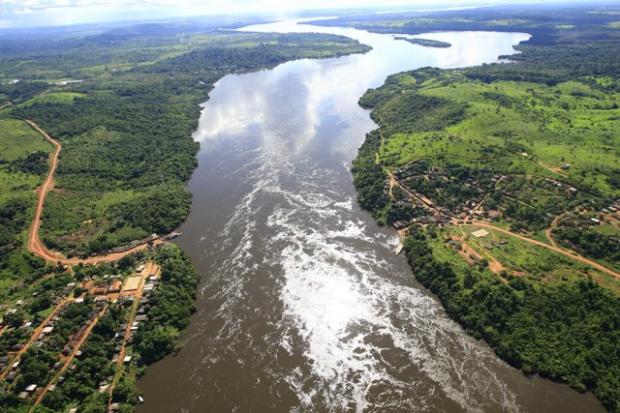
by Deep Green Resistance News Service | Sep 18, 2012 | Colonialism & Conquest, Indigenous Autonomy, Lobbying, Mining & Drilling
By Survival International
Supporters of India’s Dongria Kondh tribe are celebrating after controversial British mining company Vedanta Resources declared it will close its bauxite refinery in the state of Orissa, this December.
The news is a major breakthrough for the tribe, who have fought a David and Goliath battle against Vedanta’s plans to extract bauxite from their land.
Dongria leader, Lodu Sikaka, said today, ‘We will be happy if the company leaves. If the refinery is there, they will keep trying to take our mountain, if not today, then tomorrow, or two years, 10 years from now.’
The Lanjigarh refinery sits at the base of the Dongria Kondh’s Niyamgiri Hills, which are home to the 8,000-strong tribe, and the seat of their god Niyam Raja. The company has spent more than one billion US dollars expanding the site without securing all the required clearances, as well as knowing it was unable to source enough bauxite to run the refinery at capacity.
Vedanta has now blamed the closure on a ‘depleting stock position of bauxite’. But, there are concerns the company’s announcement is intended to pressure the government into allowing it to mine the Niyamgiri Hills. The issue has returned to India’s Supreme Court, but the case is currently adjourned.
Opposition to Vedanta’s push to mine the mountains has embroiled the company in a near decade-long dispute, and forced the Lanjigarh refinery to be run with bauxite from different mines across India. A Vedanta spokesman claimed this has cost the company half a billion dollars.
Survival International’s Director Stephen Corry said today, ‘When we started our campaign for the Dongria Kondh, we were repeatedly told it was a hopeless case and the mine would be built. It hasn’t been. The infrastructure is rusting away and now Vedanta says it will shelve its refinery. This is a fantastic vindication of the tribal people’s determination to keep the lands which are rightfully theirs, and the pressure brought to bear by thousands of their and our supporters around the world. Public pressure is the only thing which can save tribal peoples in the long-term, and it works.’
From Survival International: http://www.survivalinternational.org/news/8670

by Deep Green Resistance News Service | Sep 8, 2012 | Lobbying, Mining & Drilling, Movement Building & Support
By Melanie Jae Martin / Waging Nonviolence
Last week, a new front opened in the struggle against tar sands mining in the U.S. If you didn’t know that tar sands mining is in the works on this side of the border in the first place, you’re not alone. Most people don’t realize that tar sands extraction, which has caused tremendous pollution and environmental degradation in Canada, has crossed the border to U.S. soil, where it has taken root in Utah.
Activists on both sides of the border have been working fervently to halt the spread of tar sands in Canada and the piping of tar sands oil from Alberta to Texas. Beginning with Tar Sands Action’s mass arrests outside the White House in August 2011, followed by the Indigenous Environmental Network’s protests at the climate talks in Durban that December, activists have made Canadian tar sands mining and the Keystone XL pipeline to the Gulf of Mexico a high-profile issue this past year.
Now, direct action campaigns like the Tar Sands Blockade in Texas are continuing the effort to stop construction of the southern leg of the pipeline by disrupting business as usual for the oil industry. The threat of tar sands mining in the U.S., however, complicates the struggle. It forces geographically divergent groups to either divide their efforts or find ways to unite across vast distances. That’s why groups like Utah Tar Sands Resistance and Before It Starts are forming a strategy that can join, as well as compliment, the tornado of opposition that has formed against the tar sands industry.
Before It Starts — co-founded by Ashley Anderson, who began Peaceful Uprising with Tim DeChristopher in 2009 — is focusing primarily on national outreach, while Utah Tar Sands Resistance is focusing on forging local and regional coalitions. In both groups, activists who have experience in nonviolent direct action are prepared to ramp up efforts when the time is right. Thus far, however, the struggle has mainly been waged in the courtroom.
The environmental group Living Rivers initiated a legal challenge in 2010 to halt the progress of what’s set to become the first commercial tar sands mine in the U.S. — a forested area in Eastern Utah called PR Spring, which the state has leased a portion of to the Canadian mining company U.S. Oil Sands. Living Rivers has contested the company’s permit to dump wastewater at the mine, but last week, the judge — an employee of the Utah Department of Environmental Quality — sided with U.S. Oil Sands, granting it the right to pour toxic wastewater into the remote wilderness of eastern Utah.
The case hinged on whether or not PR Spring contains groundwater. In the hearing back in May, U.S. Oil Sands argued that the land holds no groundwater, which means that polluting the land wouldn’t contaminate water systems. But according to engineering geologist Elliott Lips, who spoke as a witness for Living Rivers, the land holds numerous seeps and springs, which the toxic tailings would pollute before either continuing to flow into rivers or percolating downward into the Mesa Verde aquifer. Ultimately, the judge was satisfied knowing that the company had conducted its own tests and would have reported water if it had found any.
Raphael Cordray, co-founder of the Utah Tar Sands Resistance, explains that tar sands mining would be incredibly destructive in a number of ways, such as polluting water, lowering river levels and destroying diverse ecosystems. “There’s so much wild land in our state, and that’s something I’m proud of,” she said. “That’s our legacy. And it’s a treasure for the whole world. Some of these places they’re trying to mine are so unique that if more people realized they existed, they’d certainly be considered national parks.”
To catalyze mass resistance, the group plans to lead trips to the site. “Helping people experience the majesty of this land firsthand will show people how much is at stake, and move them to take a stronger stand,” said Utah Tar Sands Resistance co-founder Lionel Trepanier.
Together with activists from Peaceful Uprising and Living Rivers, Utah Tar Sands Resistance visited the PR Spring site two weeks ago, and members returned home ready to ramp up efforts to halt the mining. As a member of both groups, I went along on the trip, because I wanted to see firsthand what the land looked like and whether the mining company’s claims about the absence of groundwater were accurate.
As it turns out, they couldn’t be more false. Water has etched its presence into this land, leaving creek beds that may run low at times but never go away. And clearly, the area holds plenty of water to support the large herds of deer and elk, as well as the aspen, Douglas firs and pinyon pines that make up the dense forest covering much of the land.
This vibrant green scenery was juxtaposed by the two-acre strip mine just feet away from the forest’s edge. The difference between life and death could not have been more stark. Looking into the face of such destruction, I realized it’s no longer about saving the ecosystem, or saving our water — it’s about saving life on Earth. But that kind of effort isn’t possible without a broad movement behind it.
According to Lionel Trepanier, the groups working on this issue are looking to Texas’ Tar Sands Blockade as a model for building a broad coalition that includes “diverse groups of people like ranchers, hunters, the Indigenous community and climate justice activists.”
“I think we so often assume that someone won’t agree with us just because they seem different from us, when they could be our biggest ally,” said Cordray. “We’re committed to breaking down those barriers formed by fear of reaching out, and approaching people as human beings who need clean water and a healthy environment just as much as we do.”
Read more from Waging Nonviolence: http://wagingnonviolence.org/2012/09/opposition-mounts-as-first-tar-sands-mine-in-us-gets-a-green-light/

by Deep Green Resistance News Service | Aug 26, 2012 | Biodiversity & Habitat Destruction, Colonialism & Conquest, Indigenous Autonomy, Lobbying
By Fabiola Ortiz / Inter Press Service
The Sete Quedas or “seven waterfalls” on the Teles Pires River, which runs through the Amazon rainforest states of Mato Grosso and Pará in central Brazil, are a spiritual oasis venerated by several indigenous groups.
But the 20-metre-high rocky falls are to be covered by a reservoir created by a hydroelectric dam that is to flood an area of 95 square km.
“It’s a sacred area, our creator and mother. And the ‘pajé’ (shaman) says it is where the fish lay their eggs,” João Kayabi, 52, told IPS by phone from the area. He is the chief of Kururuzinho village, home to 106 members of the Kayabi community, who speak a Tupí-Guaraní language.
For the Kayabi, the area around Sete Quedas must be left untouched, because it is the dwelling of a god who is responsible for the natural balance.
“It will be left underwater, and will only be a memory. We are trying to keep that from happening,” Kayabi said.
Sete Quedas is also sacred to two other indigenous communities: the Apiaká and the Mundurukú. For the latter, the falls are “the mother of fish” and the dwelling-place of their ancestors.
“The Mundurukú say the river is going to dry up, there will be a shortage of food, and the fish will vanish. I hope that isn’t so,” Kayabi said.
Studies on the biodiversity in that stretch of the river, carried out by Brazil’s Energy Research Company (EPE), which conducts research for the Ministry of Mines and Energy, have identified nearly 700 plant species and more than 200 species of fish, such as the spotted sorubim (Pseudoplatystoma corruscans) catfish, the common dolphinfish (Coryphaena hippurus), and the jau (Zungaro zungaro) catfish.
The Teles Pires has the reputation of being one of the world’s best rivers for fishing.
In the indigenous territory where João Kayabi’s village is located, nearly 300 people make a living from hunting, fishing and harvesting fruit.
“Up to now, our land has provided for us sufficiently. But we are concerned about what will happen in the future, and whether food will be scarce,” said the chief, a father of seven. “I’m worried about my children; I don’t know what will become of their lives.”
The Teles Pires plant will have a generating capacity of 1,820 MW. But the Companhia Hidrelétrica Teles Pires, the company that was granted the concession for building the dam, is fighting a judicial battle to be able to finish construction.
The project collides with the beliefs, customs and traditions of the Kayabi, Mundurukú and Apiaká Indians (a combined total of 12,000 people), said indigenous rights lawyer Juliana de Paula Batista, who advises native organisations in Brazil’s southwest Amazon region.
The case has been winding its way through the courts. In early August, a regional federal court ordered suspension of construction of the dam. But the attorney general’s office and Brazil’s environmental protection agency IBAMA appealed, and the suspension was lifted on Aug. 14.
“The natural resources that are indispensable for indigenous people to sustain their lifestyle and culture are being plundered,” Batista told IPS.
Early this year, the office of the public prosecutor brought a civil lawsuit to revoke the environmental license granted by IBAMA in August 2011 and bring construction to an immediate halt.
According to Batista, the environmental licensing process is flawed. “At no time has the magnitude of the impact on indigenous lands been fully understood.”
“The dam endangers fish stocks, the sacred site, water quality, rare and endemic species, vegetation in general, and hunting,” the lawyer said.
Although the tribes will not have to be relocated, they are afraid to remain in their villages “because in case of accidents, such as a break in the dam, the water would carry them away,” Batista said.
The Kayabi villages are only 50 km from the dam.
“There is no solution when it’s a government plan, we have no way to fight this,” Kayabi said. “The only way is to seek support and guidance. The dam will be built, and we are the ones who will be hurt by it, we could lose our rights.”
One of the irregularities noted by the office of the public prosecutor was the company’s failure to consult with the affected indigenous communities prior to the start of construction, as required by law. In March, work on the dam had already been suspended in response to the prosecutors’ request.
Read more from Inter Press Service: http://www.ipsnews.net/2012/08/hydropower-dam-to-flood-sacred-amazon-indigenous-site/

by Deep Green Resistance News Service | Aug 14, 2012 | Indigenous Autonomy, Lobbying
By Zachary Hurwitz / International Rivers
Federal Judge Souza Prudente of the Federal Tribunal of Brazil’s Amazon region suspended all work today on the Belo Monte Dam, invalidating the project’s environmental and installation licenses.
While the project has been suspended previously on numerous occasions, and those suspensions overturned on political grounds, this latest decision could have some legs. The decision breaks down in the following way:
- The federal judge ruled that no consultations were held with indigenous people prior to Congress issuing Decree 788 in 2005, which effectively approved the Belo Monte Dam. Article 231 of the Brazilian Constitution requires consultations to be held directly by the Congress prior to approval. In this case, approval was given three years before publication of the environmental impact assessment, after which consultations began.
- As a result, the project’s environmental license (granted in 2010) and installation license (granted in 2011) are now considered invalid, meaning that no further work can continue on the dam.
- Brazil’s National Congress must hold a series of public hearings, or consultations, with the indigenous tribes that will be affected by Belo Monte. Only after such consultations occur and are considered satisfactory, must the Congress legislate a new approval for the dam.
- The government and project consortium Norte Energia, S.A. can appeal to Brazil’s Supreme Court, Brazil’s Superior Court of Justice, the President of the Federal Tribunal, and Brazil’s Attorney General, in the next 30 days. Since this is a constitutional matter, the appeal is likely to go to the Supreme Court.
In a press conference given today late in Brasil, Souza Prudente stated that “only in a dictatorial regime does a government approve a project before holding consultations.”
The decision supports the arguments that the affected tribes have been making over the lifetime of Belo Monte: tribes will face downstream livelihood impacts as a result of a reduction in the flow of the Xingu River on the 100-km stretch known as the Volta Grande or “Big Bend,” and were never properly consulted, much less gave their consent.
In the words of the decision itself,
“installation will cause direct interference in the minimal ecological existence of the indigenous communities, with negative and irreversible impacts on their health, quality of life, and cultural patrimony, on the lands that they have traditionally occupied for time immemorial. This requires the authorization of the National Congress after holding prior consultations with these communities, as deemed by law, under the penalty of suspension of the authorization, which has been granted illegally.”
Beyond the fact that the Belo Monte Dam is now considered illegal by one of Brazil’s higher courts, the fact is that Brazil doesn’t need Belo Monte. Economic rationale for the dam is based on a projected economic growth of 5% or more a year, but over the past few quarters, GDP has been lucky to grow at even a measily rate. As far as Belo Monte’s importance to Brazil’s economic race, this is really a case of the horse following the wagon.
And, as illustrated by this historic court decision, the wagon has been trampling on indigenous people and their rights, along the way.
From International Rivers: http://www.internationalrivers.org/blogs/258/belo-monte-dam-suspended-by-high-brazilian-court

by Deep Green Resistance News Service | Jul 31, 2012 | ACTION, Mining & Drilling, Protests & Symbolic Acts, Toxification
By Peter Rugh / Waging Nonviolence
The war came home this weekend, as thousands of people whose land has been under siege by the U.S. government and corporate interests gathered in Washington, D.C. No, they weren’t victims of drone attacks or 10-plus years of fighting in Afghanistan. They were ordinary Americans, whose neighborhoods, townships and states have been struggling to put an end to fracking, a destructive form of natural gas drilling.
These veterans of the frack war were in Washington for a national convergence called Stop the Frack Attack. Over the course of two days, they held teach-ins and strategy sessions on ways to bring relief to their communities through collective action, before ending on Saturday with the first ever national march and rally against fracking. Many hailed the event as an important step to building a broad, grassroots movement to ban the drilling practice.
“I’m going to dream big,” said Jennie Scheibach with NonToxic Ohio, a group fighting the spread of fracking in northern Ohio and the disposal of fracking waste in the state’s rivers. “Standing together, rising up together, we can stop this.”
Jennie wasn’t alone. Thousands of people from across the country, from voluminous backgrounds, joined in common cause in D.C. over the weekend, raising the call for an end to fracking.
Lori New Breast of the Blackfoot Nation, whose homeland encompasses parts of Montana, Alberta, and Saskatchewan, took part in the rally. She said her community is mobilizing to reject fracking. “Oil companies would like you to think that that land is unoccupied and that we are gone. But as the care takers of the headwaters of the continent, we are still here. We do not want fracking. It is a threat to our cultural way of life.”
Members of Occupy Wall Street Environmental Solidarity were also on hand in D.C. as well, carrying banners that read, “Safe Fracking is a Lie; Occupy! Resist!” and “Frack Wall Street, Not Our Water!”
Meanwhile, suburban mothers like Vicky Bastidas, who brought her three teenage daughters to the rally, were present. She and her family have been fighting frackers from drilling near schools and playgrounds in their home town of Bethlehem, Pennsylvania. Vicky said she was heartened by a recent court decision that overturned a law barring local municipalities from banning fracking and now looks forward to passing a ban in her town.
The decision might have come too late to reverse much of the long-term damage that the unimpeded invasion of drilling has done to Pennsylvania, but nonetheless it grants Pennsylvanians a chance to set up legal barricades against the fracking bombardment. Bastidas had a message from her family to Governor Corbett and lawmakers like him: “Our water is not for sale. We can live without oil. We can live without gas. But we cannot live without water.”
This was a widespread sentiment among the approximately 4,000 demonstrators who marched from the Capitol building to the headquarters of the American Petroleum Institute (API), the oil and gas industry’s lobbying arm. Along the way they made a brief stop at the home base of the American Natural Gas Alliance (ANGA), where Delaware Riverkeeper Maya Van Rossum held up a murky, brown libation of chemical diarrhea in a clear plastic jug.
“This is frack water,” she said. “We don’t want it in our communities. We can’t drink it safely. We’re giving it back to the drillers. I bet they won’t drink it!” Uniformed in hazmat suits, Van Rossum and several of her colleagues with Delaware Riverkeeper chanted “shame” and pounded on ANGA’s doors, but a representative of the Alliance failed to appear for a taste test.
Next, demonstrators flooded the courtyard of API’s home office. “The water, the water, the water is on fire,” they hollered in unison, “We don’t need no fracking let the corporations burn.” Members of the crowd set down a 10-foot replica of a fracking rig made of bamboo and canvas at API’s door and tipped it over. The move was a symbolic representation of what they hope the burgeoning movement against fracking can accomplish nationally.
The action also pointed toward another tipping point, that of the climate, which has been driven to the brink of near collapse by the fossil fuel industry with the support of politicians, including President Barack Obama, who received $884,000 in campaign donations from the oil and gas industry in 2008. Given such a payout, it should not be surprising that Obama signed a little-noticed executive order earlier this year establishing an intergovernmental task force for the support of “unconventional” gas drilling — in other words fracking.
With the stroke of a pen, Obama picked a side in a war that began under his predecessor’s administration. In 2005, lawmakers on Capitol Hill approved the Energy Policy Act, a bill championed by then-Vice President and former Halliburton executive Dick Cheney that exempted frackers from the Safe Drinking Water Act (SDWA) and the Clean Water Act (CWA). The fracking amendments gave the world’s wealthiest energy corporations license to invade some of America’s poorest counties, poison their drinking water, foul their air and putrefy their soil. For each frack site, and there are now tens of thousands across America, drillers pump millions of gallons of water, sand and toxic chemicals into the land in order to draw oil and gas from shale rock.
Since the frack boom began, impoverished, cloistered communities sitting on millions of dollars worth of shale gas — from Pennsylvania to Wyoming, from indigenous tribal lands in Montana to the Texas border — have become ground zeros for fracking. In most cases, they are offered a short-term cash prize for land rights or desperately needed jobs in return for long-term ecological devastation. Such a strategy for prosperity, critics contend, would have left mountaintop removal strongholds in Appalachia looking like Beverly Hills long ago.
Instead, it seems the only pockets being lined are those of the corporate executives and politicians. In 2010, the fracking industry raked in $76 billion in revenues. Meanwhile, the Obama 2012 campaign is set to bring in more from oil and gas lobbyists than was raised in the previous election. If there’s hope in matching corporate campaign donations, though, it’s not with money, but rather a national movement, comprised of the diverse voices of dissent that marched through Washington on Saturday.
by Deep Green Resistance News Service | Jul 16, 2012 | Protests & Symbolic Acts, Toxification
By Common Dreams
Over 100,000 protesters took to the streets in central Tokyo on Monday to protest the country’s return to nuclear power. The demonstration was one of the largest if of its kind since Prime Minister Yoshihiko Noda announced that the country would restart its reactors last month.
Protest organizers estimated the crowd at 170,000 people. Demonstrators marched through the streets in record setting heat chanting: “Don’t resume nuclear power operation. Prime Minister (Yoshihiko) Noda should quit.”
“We are so angry because no progress has been made in terms of compensation and decontamination,” said Noboru Shikatani, a 71-year-old man who evacuated Fukushima after the disaster.
Public anger over the handling of last year’s Fukushima disaster has continued to swell. Earlier this month a damning report released by a parliamentary panel investigating the government’s handling of the disaster found that plant owner TEPCO and government regulators intentionally ignored key warnings and preparations that should have been implemented before the tsunami. The subsequent nuclear disaster to follow was “clearly man-made,” according to the panel.
“We can’t accept any resumption of nuclear power operation as the Fukushima case has not been resolved at all,” Shikatani added. “We want to bring our voice to many people by joining this kind of demonstration.”
The last of the country’s nuclear reactors had been shut down in May, following public pressure; however, the first reactor at the Oi plant in Fukui prefecture was restarted July 1, 2012 despite widespread criticism.
Noda now plans to eventually restart all 50 of Japan’s reactors, a campaign that has seen large scale protests since its announcement.
From Common Dreams: http://www.commondreams.org/headline/2012/07/16





